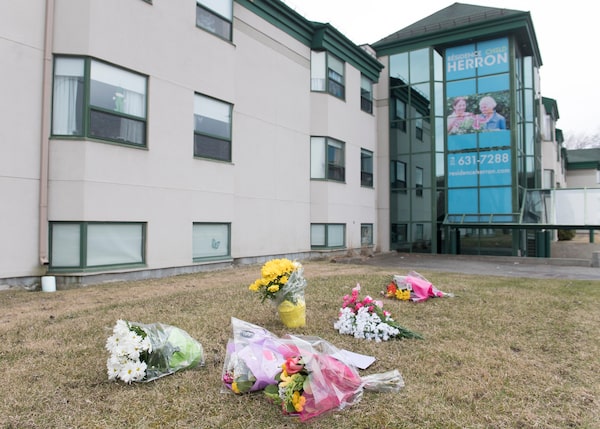
Flowers are shown outside Maison Herron, a long term care home in the Montreal suburb of Dorval on April 12, 2020.Graham Hughes/The Canadian Press
An ombudswoman’s report has found that, during the first wave of COVID-19, Quebec’s long-term care system failed in its duty to ensure the safety and dignity of residents, some of whom died alone and without palliative care.
The interim report by Marie Rinfret released Thursday depicts a system that, despite the dedication of health care workers, was disorganized, unprepared and exhausted during the spring surge in cases.
“In addition to the unknowns attached to COVID-19 was the picture repeated time and time again of people made fragile because of their age and sickness, left on their own in living environments on the brink of a precipice,” the report reads.
“This report stems from the statements of people who were, in one way or another, all victims of the dereliction of duty by too many [ong-term care homes] whose mission was to create genuine living environments.”
In a news conference following the report’s release, Ms. Rinfret said the homes were a government “blind spot” when it came to pandemic preparation.
In particular, the decision made at the onset of the pandemic to transfer a number of patients from hospitals to the care homes, which were already understaffed, poorly designed for isolating patients and lacking proper infection-control practices and the resources to fight a serious health crisis, was like “putting a match to a haystack,” she said.
The report found that the homes lacked personal protective equipment, staff were made to move between hot and cold zones due to understaffing and some residences were unable to provide basic care and services, such as hygiene and feeding.
In the most severe cases, testimonials described residents waiting in soiled incontinence briefs and sometimes wandering the residences for days or weeks in their nightgowns because nobody had time to help them dress.
Staff struggled to keep residents fed and hydrated, and often had little time for tooth-brushing or bathing, the report noted.
It found that many homes were unable to ensure residents’ dignity was respected, including their need to receive personal care and keep in touch with loved ones and caregivers.
In particular, the decision to cease visits from informal caregivers had a devastating impact on residents’ well-being, the report found.
“Residents – often among those with a severe loss of autonomy or serious cognitive impairments – facing solitude and no longer being comforted, stopped eating and in some cases, even let themselves die,” the report says.
In the news conference, Ms. Rinfret said sometimes there weren’t enough workers to give end-of-life comfort care. “I do not consider that these are people who died with dignity,” she said.
The report is based on the testimonies of over 1,350 people including residents, family members and staff in the long-term care homes, known in Quebec as CHSLDs. A majority of the deaths in the province during the first wave were among CHSLD residents, 3,890 in all.
Ms. Rinfret said the crisis also took a heavy toll on front-line health care workers, many of whom worked long shifts to try to deliver care. More than 13,000 of them fell ill and 11 died from the virus during the first wave, while others were made “soul-sick” by the suffering “that occurred before their very eyes for weeks on end,” Ms. Rinfret concluded.
She points a finger at the management of the crisis, which often took the form of a “trickle-down” process originating from higher levels rather than strong local leadership on the ground. Decisions took time to reach the ears of those in the care homes, and relief teams from the Red Cross and Canadian Armed Forces provided much-needed help but were slow to arrive, the report found.
Its five main recommendations are: focusing services on residents’ needs; ensuring a stable workforce; more rigorous infection control; better communication channels; and naming managers who can exercise strong local leadership.
In a statement, Health Minister Christian Dubé and Seniors’ Minister Marguerite Blais said the problems raised in the report are already being addressed. “In light of the conclusions offered by this progress report, I conclude that we’re already on the right path, having already implemented all the proposed actions in our plan to tackle the second wave,” Mr. Dubé said.
The government’s plan for the second wave included naming a manager for each establishment, ensuring staff is trained in infection control and hiring 10,000 patient attendants at a higher salary than had previously been offered.
The ombudswoman’s investigation was announced at the end of May, and covers the period from March until the first wave ended in June. A final report is expected to be released in the fall of 2021.
Our Morning Update and Evening Update newsletters are written by Globe editors, giving you a concise summary of the day’s most important headlines. Sign up today.